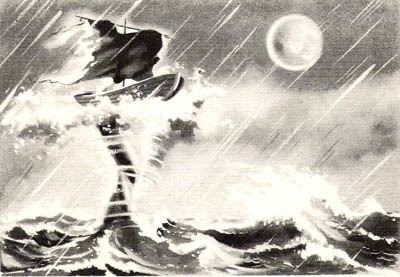Gypsy Shadow Publishing just launched my newest story, “A Tale More True” and I’m excited about it. Here’s the blurb:
History’s greatest liar, a colossal clockwork spring, a fantastic trip to the Moon…in 1769. Read it, but don’t expect truth.
What made me write a clockpunk alternate history story about an 18th Century trip to the moon? As both of my many fans know, I’m a great admirer of Jules Verne, who wrote a classic tale called From the Earth to the Moon.
One day I was searching the web about fictional trips to the moon and discovered Verne was a bit of a latecomer to that topic. Here are some of his predecessors, and the methods they used to get their characters to the moon, according to this website:
 • Lucian of Samosata, True History, 2nd Century A.D. Carried to the moon by a waterspout/whirlwind, and Icaromenippus, 2nd Century A.D. Flew to the moon in an aerial carriage.
• Lucian of Samosata, True History, 2nd Century A.D. Carried to the moon by a waterspout/whirlwind, and Icaromenippus, 2nd Century A.D. Flew to the moon in an aerial carriage.
• Johannes Kepler, The Dream, 1634. Transported to the moon by aerial demons.
• Bishop Francis Godwin, The Man in the Moone, 1638. Pulled to the moon  by trained geese.
by trained geese.
• Cyrano de Bergerac, Comic History of Estates and Empires of the Moon, 1650. Launched to the moon by firecrackers.
• Daniel Defoe, The Consolidator, 1705. Rode an ‘engine’ called The Consolidator.
• Vasily Kevshin, Newest Voyage, 1784. Flew to moon in a self-constructed flying apparatus.
• Wilhelm Kuchelbecker, Land of Acephals, 1824. Flew in a balloon.
• Edgar Allan Poe, The Unparalleled Adventure of One Hans Pfaall, 1835. Flew in a balloon equipped with an air compressor.
I was struck by the fact that no one had written about going to the moon using spring power. During the 1600s and 1700s, they knew about the energy-storage properties of springs, the driving force in most clocks, so I thought someone should write that story.
During the research I also happened upon the interesting historical figure, Baron Hieronymus Carl Friedrich von Münchhausen, well known for his fanciful fibs, including tall tales about making two trips to the moon. In one trip he climbed a tall beanstalk, and in the second a hurricane lifted his ship up to the moon. I wondered if a rival of the Baron might be upset by these lies and might set about to prove Münchhausen wrong.
That’s how “A Tale More True” was born.
Subsequently I happened upon this website, and learned that David Russen had written A Voyage to the Moon in 1703, in which a giant spring is used to reach the moon. Oh, well, I wasn’t the first after all!
For you engineers and realists out there, yes, I know a human would not survive the acceleration of being ‘sprung’ to Earth’s escape velocity. However, it might be possible to construct a huge spring within a cylinder, have the spring drawn down in compression, draw a near vacuum in the cylinder, and launch a solid, unmanned projectile to escape velocity. Why you’d want to do that, I have no idea, but it might be possible.
Still, it’s fun to imagine someone building a giant spring in 1769 and travelling to the moon two centuries early. And as long as I was changing history anyway, I figured I’d also change the moon. In most of those early space-travel stories, (except Verne’s), the moon was inhabited. So why not populate the moon in my story?
And, though it’s outside my normal line, why not make the story humorous?
Anyway, enough said. The book has been sprung upon an unsuspecting world, and is available at Gypsy Shadow Publishing, Amazon, Smashwords, and other outlets as well. You’ll enjoy it, thinks—
Poseidon’s Scribe
